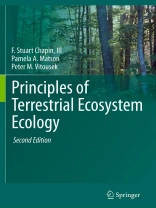Features review questions at the end of each chapter; Includes suggestions for recommended reading; Provides a glossary of ecological terms; Has a wide audience as a textbook for advanced undergraduate students, graduate students and as a reference for practicing scientists from a wide array of disciplines
Tabla de materias
Preface.- I. CONTEXT.- The Ecosystem Concept.- Earth’s Climate System.- Geology, Soils, and Sediments.- II. MECHANISMS.- Water and Energy Balance.- Carbon Inputs to Ecosystems.- Plant Carbon Budgets.- Terr Decomposition and Ecosystem Carbon Budgets.- Plant Nutrient Use.- Nutrient Cycling.- Trophic Dynamics.- Species Effects on Ecosystem Processes.- III. PATTERNS.- Temporal Dynamics.- Landscape Heterogeneity and Ecosystem Dynamics.- IV. INTEGRATION.- Changes in the Earth System.- Managing and Sustaining Ecosystem.- Abbreviations.- Glossary.- References.
Sobre el autor
F. Stuart Chapin, III is an ecosystem ecologist whose research addresses the sustainability of ecosystems and human communities in a rapidly changing planet. This work emphasizes the impacts of climate change on Alaskan ecology, subsistence resources, and indigenous communities, as a basis for developing climate-change adaptation plans. Pamela Matson is dean of the School of Earth Sciences at Stanford University, USA. She previously worked at NASA and at the University of California Berkeley. Her professional titles at Stanford are Chester Naramore Dean of the School of Earth Sciences, and Richard and Rhoda Goldman Professor of Environmental Studies. Peter Vitousek is at the forefront of research on biological diversity, his research focus is Hawaii. His Stanford Lab is studying nutrient cycling in forest ecosystems as well as the effects of invasions by exotic species.












